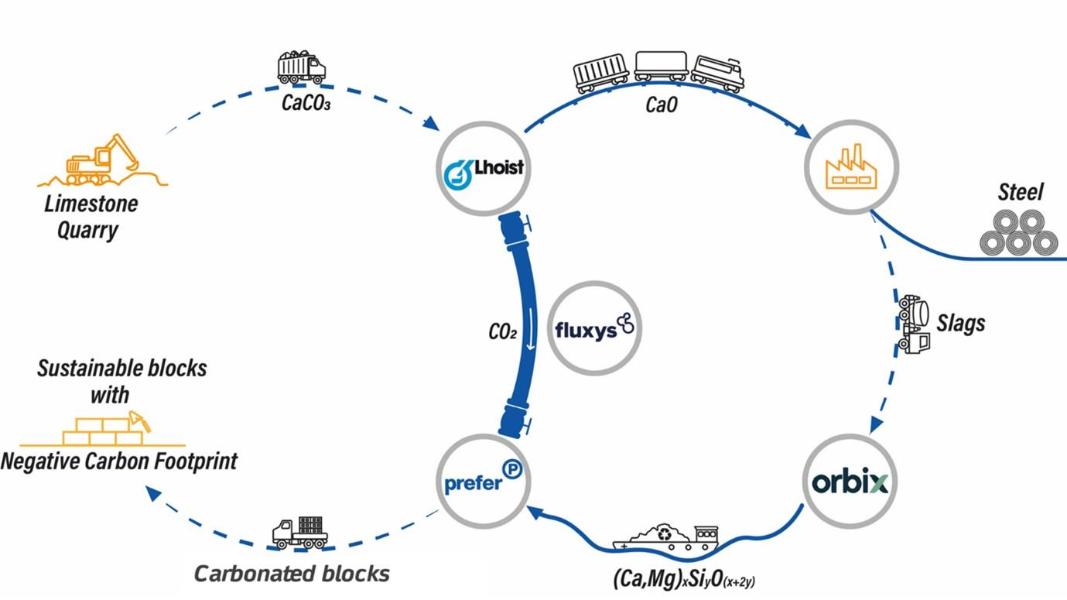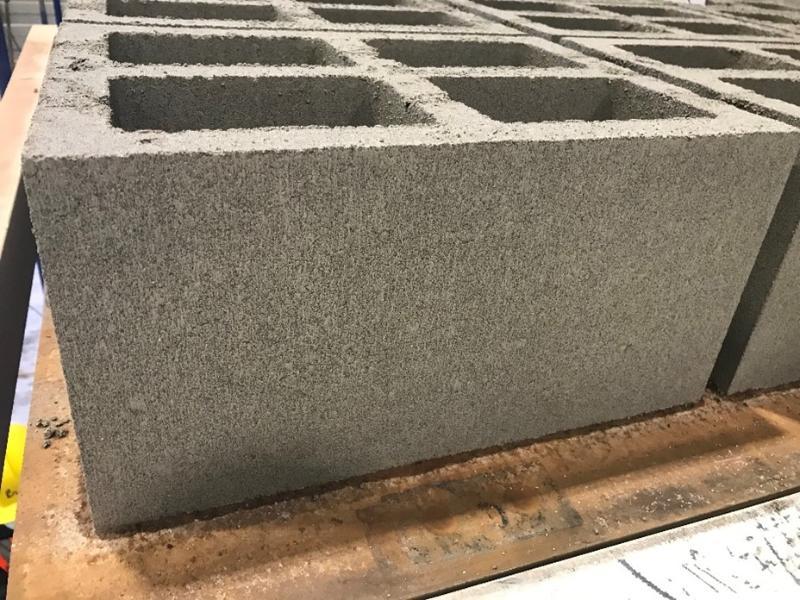Four companies from Belgium get together in a local, circular economy project using byproducts of steelmaking to create a masonry block that cuts carbon dioxide emissions
If there was ever a product that turned a problem into a solution, it’s the innovative masonry block developed by four Belgian companies. Most concrete blocks are made with cement, which causes greenhouse gas emissions. The innovative Belgian block is made with carbon dioxide gathered from other industrial processes. It eats carbon dioxide and turns it into something useful.
Cement production is the source of 2.4% of global carbon dioxide emissions from industrial and energy sources. So the four companies, who all have facilities near Liège, are together developing a product that could have significant implications for industry across the globe and for the battle against global warming.
“Our project is very innovative,” says Antoine Gregoire, development manager at Prefer, one of the four companies. “It is circular and local.”
Here’s how it works:
- Lhoist produces lime (including dolomitic lime), limestone and mineral solutions for a growing range of applications, including steel production. When it heats stone to make lime, it creates carbon dioxide. Instead of letting the carbon dioxide escape, it will send the gas down a pipeline run by Fluxys, a company that usually works in the transmission of natural gas. The 2 km pipeline will arrive at Prefer, a company that makes concrete materials.
- Orbix, which develops sustainable materials for the construction and steel sectors, will take the slag left over after Lhoist’s lime is used for steel production by another company. It will ship the slag to Prefer by boat.
- Finally, Prefer will bring the slag and carbon dioxide together to make a block. Specifically, the carbon dioxide will be used to harden the block, which the companies call CO2ncrEAT, because it effectively eats CO2.

It’s an efficient process, because there’s no need for purification or liquefaction of the carbon dioxide. No energy is expended preparing the carbon dioxide, either. Within two years, the four companies plan full production of CO2ncrEAT blocks from carbon dioxide that would otherwise have gone into the atmosphere to contribute to global warming.
Belgium masonry block gets EU bank help
But development of an innovative industrial project is very expensive. The four companies put the cost at €7.5 million. So they wanted to get backing from the Innovation Fund, a European Commission funding programme for innovative, low-carbon technologies.
After its first application to the Innovation Fund, CO2ncrEAT received support from experts on the European Investment Bank’s Innovation Fund team. Under the Innovation Fund framework, the European Investment Bank offers tailored support for selected projects, to help make them ready to be put into action.
“We had to show that the project is economically viable, taking into account the contribution of all four members of the consortium,” says Matthieu Banal, a European Investment Bank finance advisor who worked with the companies.
The project will be the first European commercialisation of “CO2-negative” construction blocks in Europe.
“Projects that apply for the Innovation Fund grant need to demonstrate that they are not only innovative, but also mature, scalable and can play a relevant role in cutting carbon emissions,” says Clotilde Rossi di Schio, a European Investment Bank technical advisor on the project.
There are two calls each year for submissions to the Innovation Fund. The European Commission sends up to 40 project applications per call to the EIB Innovation Fund team, which consists of experts from the Bank’s Advisory Services and the Projects Directorate for financial and technical assistance.
EU finance to offset risks of Belgium masonry block
The European Climate Infrastructure and Environment Executive Agency (CINEA), an EU body, pre-selected the project for a grant of €4 million, 60% of the capital expenditure for the development of the process under an Innovation Fund call for small projects (below €7.5 million). The preparation of the grant agreement is on-going, and the grant agreement should be signed in May.
“Without the grant, it would be too expensive” to develop the manufacturing process for these blocks, says Gregoire. “We couldn’t develop and build the whole industrial process and ensure profitability. The risk linked to the innovation and the capital expenditure needed to build the factory are too high.”
The grant will help pay for a “capture and conditioning unit” at Lhoist, the pipeline to Prefer, and a carbonation chamber at Prefer where the blocks will be formed and hardened by the carbon dioxide.

The proximity of these four companies near Liège means that the process is efficient and doesn’t end up creating lots of carbon dioxide in transporting the slag or lime over great distances. But it’s something that could work anywhere around the world with a similar group of local companies.
“Everywhere you find slag and industrial CO2, it will be possible to produce CO2ncrEAT blocks, with their negative carbon footprint,” Gregoire says.
That could be a big step forward to a lower carbon footprint for the construction sector.
